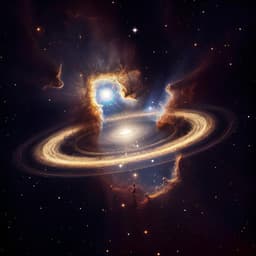
Space Sciences
Evidence of structural discontinuities in the inner core of red-giant stars
M. Vrard, M. S. Cunha, et al.
This exciting research delves into the inner core structure of red-giant clump stars using asteroseismic data from the Kepler satellite. With evidence suggesting large core structural discontinuities in around 6.7% of the sample, it opens up new possibilities for understanding stellar evolution. Conducted by Mathieu Vrard and colleagues, this study sheds light on the intermittent nature of these phenomena.
~3 min • Beginner • English
Introduction
Asteroseismology of red giants, enabled by CoRoT and Kepler, reveals mixed modes arising from coupling between acoustic waves in the envelope and gravity waves in the core, probing the full stellar interior. Sharp structural variations (glitches) modulate oscillation frequencies when their scale is comparable to or smaller than the mode wavelength. Recent theory predicts that core glitches in red giants induce cyclic modulations in mixed-mode frequencies, with scale and amplitude set by the location and strength of the discontinuity. This study systematically searches for such core glitches in clump stars to test core structure and mixing during core-helium burning and assess their implications for stellar evolution models.
Literature Review
Prior work established the use of mixed modes to distinguish hydrogen- from helium-core burning red giants and developed asymptotic descriptions of mixed modes under smooth structures. Theoretical analyses predicted glitch-induced cyclic modulations in g-mode period spacings and mixed-mode frequencies for red giants. Several potential core structural features have been proposed: the hydrogen-burning shell, the first dredge-up discontinuity, and signatures from the helium flash. For low-mass clump stars, the hydrogen-burning shell is too broad to act as a sharp glitch, the first dredge-up discontinuity is smoothed by the luminosity bump before the clump, and helium flash–related discontinuities are too small to imprint detectable modulations. A chemically-induced discontinuity at the boundary between the convective core and adjacent radiative layers, produced by overshoot mixing with radiative stratification, is theoretically expected to create a discontinuity in the Brunt–Väisälä frequency inside the g-mode cavity and thus a measurable glitch signature. Models with adiabatic overshoot place the discontinuity at the cavity edge and would not produce a detectable frequency modulation.
Methodology
Data and target selection: From Kepler clump stars with sufficient signal-to-noise to measure ΔΠ1 and masses below 1.9 solar masses, 359 stars (first by KIC) were selected to ensure similar helium-core masses and evolutionary behavior. Global seismic parameters (Δν, νmax) and individual mode frequencies were measured using autocorrelation refined by the universal red-giant oscillation pattern, with background fitted via Bayesian methods. Radial and quadrupole p modes were identified and excised; the remaining spectra were smoothed and mixed modes detected as significant peaks above a 99.9% confidence threshold. Rotational splittings were checked via peak multiplicity. Peaks were fitted with Lorentzian or sinc profiles depending on mode resolution; modes with more than one frequency bin exceeding 8 times the background were considered resolved. Metallicities were taken from APOKASC DR16 for 246 of 359 stars.
Glitch identification and fitting: Mixed-mode frequencies were transformed to stretched periods to remove the p-component and reveal deviations from regular spacing attributable to glitches. Stars with significant deviations beyond frequency uncertainties were considered candidates. Alternative explanations (parameter adjustments in ΔΠ1, coupling q, small separation dℓ0, and rotation) were explored over defined parameter grids to avoid alias solutions. When no alternative fit sufficed, a glitch was adopted. For each confirmed case, the mixed-mode pattern was modeled with an analytical expression including coupling and a step-function glitch phase with three free parameters: glitch amplitude A, relative buoyancy radius position x, and phase ε. Model frequencies were converted to stretched periods and fitted to observations using MCMC (emcee) to infer parameters and uncertainties; the signature period Tsig was derived using Tsig ≈ ΔΠ1/x in the weak-coupling limit. Reliable fits were obtained for 23 of 24 candidates.
Stellar modeling: Nine evolutionary sequences were computed with MESA for masses 1.0, 1.3, 1.6 solar masses and metallicities [Fe/H] = −0.25, 0.0, +0.25. During the clump, step-function overshoot of 0.5 Hp with a radiative temperature gradient was adopted beyond the convective core to produce a chemical discontinuity (and corresponding jump in Brunt–Väisälä frequency) within the radiative g-mode cavity. Models were evolved from core-He ignition to the onset of semiconvection (about 30–40% central helium depletion), after which structural uncertainties grow. Glitch positions (buoyancy radius at the discontinuity) and amplitudes A = (Nout/Nin) − 1 were extracted along the clump evolution for comparison with observations.
Key Findings
- Among 359 low-mass Kepler clump stars, 24 (6.7%) showed significant cyclic deviations in mixed-mode spacing consistent with core glitches; robust model fits were achieved for 23 stars (one was excluded due to ambiguity at high frequency).
- Inferred dimensionless glitch positions x and amplitudes A show broad dispersions: mean x ≈ 0.031 with standard deviation ≈ 0.014; mean A ≈ 3.08 with standard deviation ≈ 1.79. In the fitted sample, x spans roughly 0.012–0.085 and A spans roughly 0.461–7.292 (per Table 1).
- The detected modulations indicate strong discontinuities located near the edges of the gravity-wave cavity, consistent with a chemical discontinuity at the boundary between the convective core and the adjacent radiative region produced by extra mixing with a radiative thermal stratification.
- Stellar models with radiative overshoot reproduce the observed ranges of glitch positions and amplitudes and their trends with metallicity and evolution. Models assuming adiabatic stratification in the overshoot region would not produce detectable glitch signatures because the discontinuity lies at the cavity edge.
- Glitch amplitudes below detection are expected near the start of the clump when the discontinuity is small; the minimum ΔΠ1 among stars with detected glitches is 246 s, compared to ≈229 s at clump start, constraining the timescale for building discontinuities.
- The incidence of detected glitches (~1 in 8 clump stars) is not explained by differences in data quality, seismic properties, masses, metallicities, or evolutionary state distributions between the glitch and non-glitch subsamples, indicating a physical origin for the dichotomy beyond simple detectability.
- Two scenarios are discussed: (1) glitches are ubiquitous but usually below detection thresholds (not favored by models), or (2) glitches are intermittently smoothed by an unknown physical process during clump evolution.
Discussion
The systematic detection of cyclic mixed-mode modulations in a subset of clump stars confirms the presence of core structural discontinuities and directly probes the near-core mixing region. The localization of glitches near the inner edge of the g-mode cavity, along with modeling, supports radiative thermal stratification in the overshoot region beyond the convective core. This challenges models employing adiabatic overshoot during the clump, which would not yield observable glitch signatures. The lack of differences in mass, metallicity, ΔΠ1, Δν, or data quality between stars with and without glitches argues against observational biases or simple evolutionary effects driving the detection dichotomy. Given that models predict detectable amplitudes across the clump, the results point toward time-variable processes that can intermittently smooth or rebuild the discontinuity (e.g., yet-unmodeled mixing phenomena), or more complex detection thresholds than currently assumed. These findings provide stringent constraints on core mixing prescriptions and the thermal structure in clump stars, with implications for stellar age and structure inferences used in galactic archaeology.
Conclusion
This study provides observational evidence of core structural discontinuities in clump red giants, detected as cyclic modulations in mixed-mode spacings in approximately 6.7% of a homogeneous Kepler sample. The properties of the signatures are consistent with a chemical discontinuity at the edge of the convective core produced by extra mixing with a radiative thermal stratification, and they are incompatible with models adopting adiabatic overshoot in the clump. The similar properties of stars with and without detected glitches suggest that discontinuities may form and dissipate intermittently due to unmodeled processes. These constraints should guide the development of improved stellar evolution models for the clump phase, including refined treatments of overshoot, thermal stratification, and semiconvection. Future work should expand samples, improve metallicity coverage, follow evolution in time where possible, and explore the physics of intermittent mixing and its impact on seismic diagnostics.
Limitations
- Sample restrictions: only Kepler clump stars with sufficient signal-to-noise and masses below 1.9 solar masses; metallicities available for 246 of 359 stars (APOKASC incompleteness).
- Detection thresholds: only glitches with amplitudes above roughly one tenth of ΔΠ1 and above the noise were reliably identified; weaker or shorter-period signatures may be missed.
- Modeling choices: the seismic glitch was modeled as a step-function; the frequency range of observed modes is too narrow to distinguish among different glitch profiles or frequency-dependent amplitudes.
- Theoretical models adopted step-function overshoot with radiative stratification and were halted at the onset of semiconvection due to uncertainties; consequently, later clump evolution and semiconvective effects on glitches were not explored.
- Nonlinear relation between true glitch amplitude and observed signature amplitude complicates direct amplitude inference; simple approximations apply only in limited regimes (A less than about 2), while most observed A exceed this.
Related Publications
Explore these studies to deepen your understanding of the subject.







